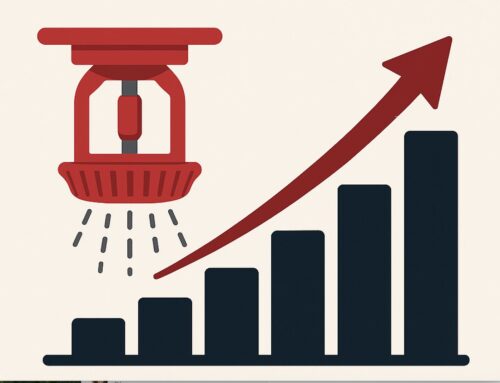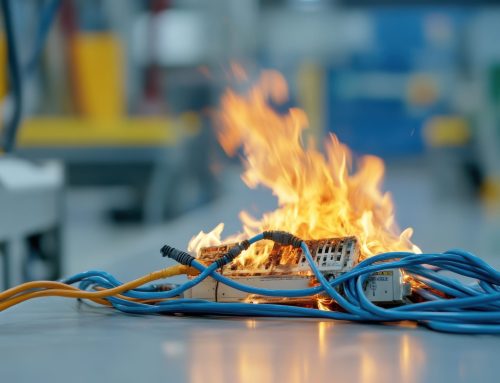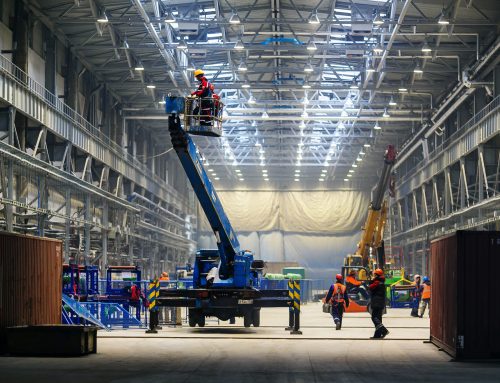As a building manager or business owner, it’s important to be prepared for any type of fire that may ignite in your facilities. We’ve compiled a list of the top fire protection terms to know in preparation for a visit from your facility’s fire protection company. Having an existing knowledge of these terms will help ensure the most productive visit with your fire protection technician.
We’ll break down the top terms to know in the following areas: fire sprinkler systems, fire alarm systems, fire extinguishers, and vehicle suppression systems.
Fire Sprinkler System
According to NFPA 13 (Standard for the Installation of Sprinkler Systems), there are four different types of fire sprinkler systems: wet, dry, preaction, and deluge. It’s important to know which type of system your building is outfitted with so that you can effectively communicate with your fire protection service provider should any issues arise.
Wet pipe sprinkler systems have a constant supply of water that flows immediately after ceiling temperatures get hot enough that the sprinkler head’s glass bulb (or fusible link) breaks.
In dry systems, the pipes are not constantly supplied with water. The water is held behind a valve and only released into the pipes once the glass bulb breaks.
Deluge systems have sprinkler heads that are always open, and pipes that remain empty until water is released via a control valve. Because these sprinkler heads don’t rely on broken bulbs/fuses to open, water will come out of all heads at once.
Pre-action systems are dry piped. Once fire is detected, water is released into the pipes. From there, each sprinkler head must be triggered by bulbs/fuses breaking. These systems are great in water-sensitive environments.
Fire Alarm System
Fire alarm systems are a crucial part of fire protection systems. The fire alarm control unit (FACU) is the brain of your fire alarm system. There are three conditions that you’ll see at the FACU: alarm, trouble, and supervisory. An alarm status means that fire or smoke has been detected. Trouble means there is a device malfunction somewhere within the fire protection system. A supervisory condition means that there is a problem with a system, process, or equipment that’s monitored by the FACU. Knowing these terms can be the difference between life, death, and severe building damage.
Fire Extinguishers
When it comes to portable fire extinguishers, it’s important to know how to discharge them. The PASS system is a user-friendly acronym that helps users remember how to use a fire extinguisher: pull, aim, squeeze, sweep.
Not all fire extinguishers are made the same. There are different classes of fire (A, B, C, D, and K) that need to be treated by different types of approved extinguishers. It’s important that you have the appropriate type(s) of fire extinguishers located in your facility. Note that it may be appropriate to have different types of extinguishers located in your building according to the potential fire types in different areas.

Vehicle Systems
Vehicle fire suppression systems are a crucial aspect of any industrial vehicle. High operating temperatures, friction from moving parts, and fuel/oil tanks create prime conditions for unwanted fires to arise. To combat these fires, your industrial vehicle should be outfitted with one of these three types of vehicle suppression systems: wet, dry, or dual.
Wet systems use a wet chemical agent that suppresses fire, cools superheated surfaces, and blankets fuel to help prevent reflash. Dry systems use a dry chemical agent to smother and extinguish flames. Dual systems utilize both wet and dry agents to extinguish, cool, and minimize reflash on industrial vehicle fires.
Fire Systems, Inc.
Knowing these fire protection terms will help you spot any potential issues and effectively communicate them to your fire protection company. If you are in need of a fire protection company to service your facility, consider Fire Systems, Inc.
Fire Systems, Inc. is a family-owned and operated fire protection company in the Atlanta area. As experts in the field, we’re here for any and all of your fire protection needs. Visit our website or give us a call at 770-333-7979.







